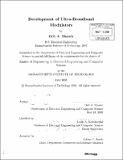Development of ultra-broadband modulators
Author(s)
Shamir, Orit A
DownloadFull printable version (46.05Mb)
Other Contributors
Massachusetts Institute of Technology. Dept. of Electrical Engineering and Computer Science.
Advisor
Leslie A. Kolodziejski.
Terms of use
Metadata
Show full item recordAbstract
Optical signal modulation is a cornerstone of communication, allowing the transfer of information by electrically encoding data onto an optical carrier. Modulation with ultra-broadband capability enables the generation of arbitrary waveforms using the electro-optic effect. By separating an incoming pulsed optical source into a frequency comb through the use of arrayed waveguide gratings, and employing both phase and amplitude modulation using Mach Zehnder Interferometers, an arbitrary waveform is constructed following frequency channel recombination. Modulation of frequency combs centered at an operational frequency of 800nm requires the use of GaAs-based and InP-based materials that are transparent at 800nm. The design and growth of III-V structures, the fabrication of ultra-broadband modulators and the design of arrayed waveguide gratings are detailed in this work. Three distinct structures are presented along with a compatible fabrication procedure for the construction of discrete modulators. The work is culminated with a discussion of further steps in the realization of an optical arbitrary waveform generating system.
Description
Thesis (M. Eng.)--Massachusetts Institute of Technology, Dept. of Electrical Engineering and Computer Science, 2008. Includes bibliographical references (p. 129-132).
Date issued
2008Department
Massachusetts Institute of Technology. Department of Electrical Engineering and Computer SciencePublisher
Massachusetts Institute of Technology
Keywords
Electrical Engineering and Computer Science.